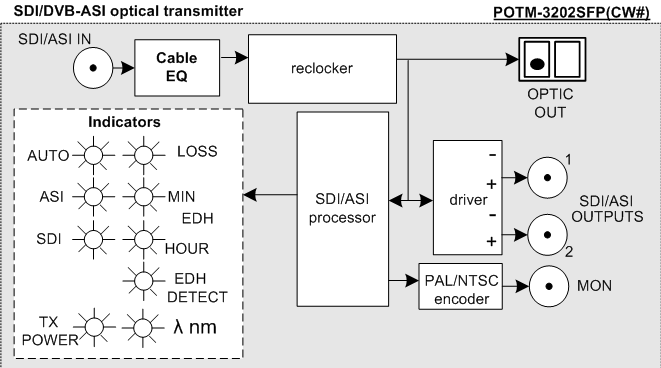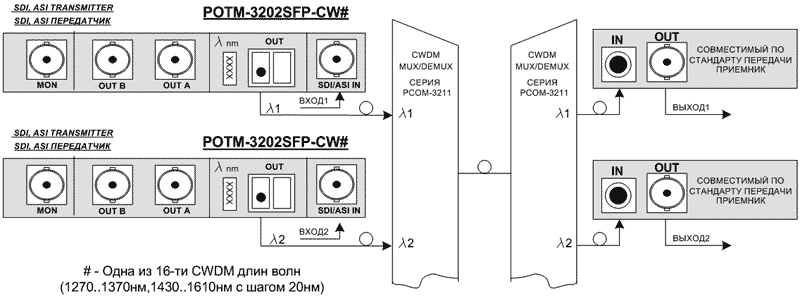|
|
Main / Optical interfaces / POTM-3202 SFP
| POTM-3202SFP(CW) series SDI/ASI optical transmitters |
PROFLEX™ POTM-3202SFP(CW) optical transmitters accept the 270Mbps SDI/ASI streams to send over the single-mode optical fiber.
A hot-swappable SFP module allows to change lasers easily, provides the real-time diagnostic information about TX power and wavelength.
The POTM-3202SFP module occupies one slot in the PROLFEX 1U/3U racks so that up to four transmitters fit into a 1U rack and up to seventeen into a 3U rack.
Features
- autodetection of input signal standard with manual override capability
- EDH status indication (min/hour) and signal loss indication
- automatic cable equalisation and reclocking
- two BNC outputs with reclocked/restored input signal
- PAL/NTSC monitor output for SDI input signal
- hot-swappable SFP module providing the diagnostic information about TX power and wavelength
- CWDM system compatibility
POTM-3202SFP(CW#) laser wavelengths:
- a single-signal system: 1310±20nm (POTM-3202SFP) or 1550±20nm by request (POTM-3202SFP/1550)
- WDM system: 1310±20nm (POTM-3202SFP) and 1550±20nm (POTM-3202SFP/1550)
- CWDM system: the 1270~1610nm band with 20nm steps, (modification indexes: POTM-3202SFPCW##, where ## – the laser wavelength; for example, POTM-3202SFPCW1530)
Compatible with all PROFITT's optical receivers.
Technical specifications
- Input
- Electrical
| Standards |
SMPTE259M A,B,C,D, DVB/ASI |
| Number of inputs |
one, with the reclocking |
| Input impedance |
75 Ohm |
| Return loss |
better than 18dB at 270MHz |
| Cable equalization |
automatic, up to 300m for SD SDI (270Mb/s). Belden 1694A or similar cable |
| Connector type |
BNC |
- Output
- Output (digital, electrical)
| Signal standard |
as per optical input |
| Number of outputs |
two, reclocked |
| Return loss |
better than 18dB at 270MHz |
| Amplitude |
800mV±10% |
| Connector type |
BNC |
| Signal rise/fall time |
700ps for SDI |
| Jitter |
less than 0.2UI |
- Output (PAL/NTSC analog monitor for SDI)
| Number of outputs |
one |
| Output impedance |
75 Ohm |
| Amplitude |
1000mV at 75 Ohm |
| Phase/amplitude error |
less than 3% |
| Frequency response |
less than 2% at 5.5MHz |
| Connector type |
BNC |
- Optical
| Number of outputs |
one |
| Connector type |
LC/PC, single-mode fiber |
| Laser wavelength |
1310±20nm (1550±20nm by request), FP laser (DFB laser by request) |
| CWDM wavelengths |
1270~1370nm, 1430~1610nm with 20nm steps, DFB laser |
| Optical output power |
0~3 dBm |
General description
The optical transmitter POTM-3202SFP accepts the SDI/ASI input signal, provides an automatic cable equalization and reclocking. The restored signal is optically output (via a laser), a copy of the signal is provided at an electrical output and simultaneously processed to detect the standard, EDH status, to decode it. In case of an SDI signal - it is provided at the monitor output in PAL/NTSC format.
POTM-3202SFP simplified schematics:

POTM-3202SFP rear panel and connectors

Controls and indicators
All the controls and indicators are located at the module's frontal board

Modes of operation:
- INP MODE – input signal standard automatic/manual selection
- TX POWER – display of the laser TX optical power
- λ nm – display of the laser TX optical wavelength
Indicators:
- LOSS – lit when no input signal is detected
- EDH DET – lit when an SDI signal with the EDH is present
- EDH MIN/HOUR – lit when two or more EDH errors were detected within one hour/one minute interval
- INPUT STATUS - input signal standard indication:
- AUTO - autodetection mode is ON
- ASI - the ASI input signal is detected
- SDI - the SDI input signal is detected
Remote control from a PC
All “PROFLEX”-family devices are capable of a remote control from a PC via a PROFITT's proprietaty software package.
An optional CPU module installed in a PROFLEX rack provides for Ethernet connectivity.
Application example
In case of a single-fiber usage, just connect it to the transmitter's output.
In case of the CWDM you should connect the transmitters' outputs to an optical MUX/DEMUX observing the wavelength markings.

|